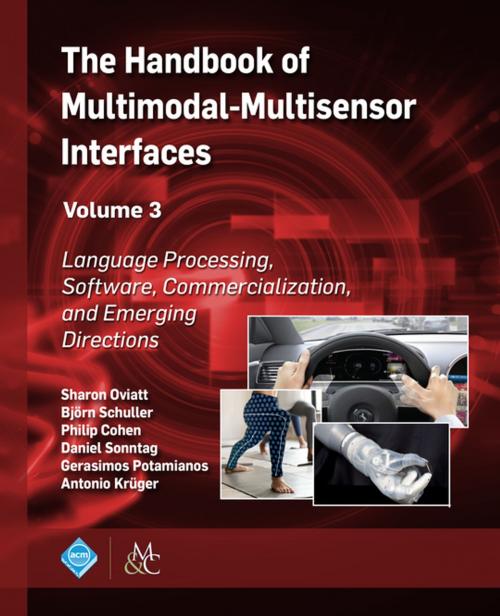The Handbook of Multimodal-Multisensor Interfaces, Volume 3
Language Processing, Software, Commercialization, and Emerging Directions
Nonfiction, Computers, Advanced Computing, Programming, User Interfaces, Computer Science| Author: | ISBN: | 9781970001747 | |
| Publisher: | Association for Computing Machinery and Morgan & Claypool Publishers | Publication: | June 25, 2019 |
| Imprint: | ACM Books | Language: | English |
| Author: | |
| ISBN: | 9781970001747 |
| Publisher: | Association for Computing Machinery and Morgan & Claypool Publishers |
| Publication: | June 25, 2019 |
| Imprint: | ACM Books |
| Language: | English |
The Handbook of Multimodal-Multisensor Interfaces provides the first authoritative resource on what has become the dominant paradigm for new computer interfaces-user input involving new media (speech, multi-touch, hand and body gestures, facial expressions, writing) embedded in multimodal-multisensor interfaces.
This three-volume handbook is written by international experts and pioneers in the field. It provides a textbook, reference, and technology roadmap for professionals working in this and related areas.
This third volume focuses on state-of-the-art multimodal language and dialogue processing, including semantic integration of modalities. The development of increasingly expressive embodied agents and robots has become an active test bed for coordinating multimodal dialogue input and output, including processing of language and nonverbal communication. In addition, major application areas are featured for commercializing multimodal-multisensor systems, including automotive, robotic, manufacturing, machine translation, banking, communications, and others. These systems rely heavily on software tools, data resources, and international standards to facilitate their development. For insights into the future, emerging multimodal-multisensor technology trends are highlighted in medicine, robotics, interaction with smart spaces, and similar areas. Finally, this volume discusses the societal impact of more widespread adoption of these systems, such as privacy risks and how to mitigate them. The handbook chapters provide a number of walk-through examples of system design and processing, information on practical resources for developing and evaluating new systems, and terminology and tutorial support for mastering this emerging field. In the final section of this volume, experts exchange views on a timely and controversial challenge topic, and how they believe multimodal-multisensor interfaces need to be equipped to most effectively advance human performance during the next decade.
The Handbook of Multimodal-Multisensor Interfaces provides the first authoritative resource on what has become the dominant paradigm for new computer interfaces-user input involving new media (speech, multi-touch, hand and body gestures, facial expressions, writing) embedded in multimodal-multisensor interfaces.
This three-volume handbook is written by international experts and pioneers in the field. It provides a textbook, reference, and technology roadmap for professionals working in this and related areas.
This third volume focuses on state-of-the-art multimodal language and dialogue processing, including semantic integration of modalities. The development of increasingly expressive embodied agents and robots has become an active test bed for coordinating multimodal dialogue input and output, including processing of language and nonverbal communication. In addition, major application areas are featured for commercializing multimodal-multisensor systems, including automotive, robotic, manufacturing, machine translation, banking, communications, and others. These systems rely heavily on software tools, data resources, and international standards to facilitate their development. For insights into the future, emerging multimodal-multisensor technology trends are highlighted in medicine, robotics, interaction with smart spaces, and similar areas. Finally, this volume discusses the societal impact of more widespread adoption of these systems, such as privacy risks and how to mitigate them. The handbook chapters provide a number of walk-through examples of system design and processing, information on practical resources for developing and evaluating new systems, and terminology and tutorial support for mastering this emerging field. In the final section of this volume, experts exchange views on a timely and controversial challenge topic, and how they believe multimodal-multisensor interfaces need to be equipped to most effectively advance human performance during the next decade.















